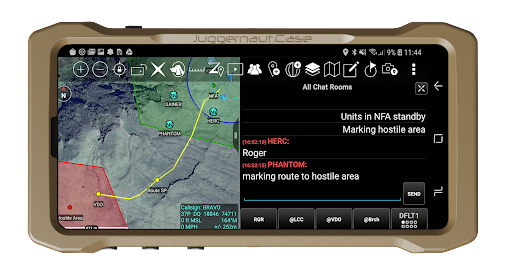How mobile mesh can enable coordinated joint multi-domain military operations

There is one overarching theme or trend that industry partners have been hearing from the U.S. Department of Defense (DoD) over the past decade – the adversaries of the future will be near-peer threats that have built their military capabilities with the distinct purpose of defeating the United States. This has been a common thesis that we’ve witnessed across all of the DoD’s recent actions, the plans that it has put on paper, and the topics that military leaders have discussed at conferences, panel discussions, and industry events.
It’s clear that if the U.S. military is going to defeat this new generation of near-peer adversaries, every disparate service and organization within the DoD needs to be on the same page – operating from a single source of truth and a common operating picture. It will also need help from its friends – allied nations and coalition partners.
Unfortunately, this is easier said than done.
Play together – but stay apart
The individual services that comprise the U.S. military – the Army, Navy, Air Force, and Space Force – are mostly operating on networks and with signals and systems that were developed and implemented separately. This makes it difficult for our own military to integrate their communication and network infrastructure to provide senior military leaders with integrated common operating pictures, comms, and command infrastructure.
That challenge is exasperated with the introduction of international coalition partners. These allied nations not only operate with their own networks and infrastructure that don’t easily interoperate with our own, but also often face security and classification challenges when attempting to share U.S. data and capabilities. Factor in the need to operate collaboratively while disaggregated because of the advanced fires capabilities of near-peer adversaries, and the challenge of coordinated operations between multiple nations becomes even harder to overcome.
…mobile mesh network devices can be handed out to every warfighter in theater – regardless of service or nation…These devices will allow allied warfighters to communicate via text and see each other’s physical location on a map, delivering almost an almost immediate, integrated operating picture and comms infrastructure.
To solve this problem and give the military and its allies the integrated, modern, interoperable infrastructure that it needs for communications, command, and control, the services have been working tirelessly to make their networks interoperate. To that purpose, each individual service has been embracing new technologies that facilitate integration and interoperability as well as conducting tests and assessments to gauge their ability to coordinate when it really matters.
The Army’s version of these tests is known as Project Convergence, which is a multi-year, all-service, multi-national event held in conjunction with some of our allied partners – including Australia and the UK. These training events are designed to ensure that all ground, air, and naval assets can communicate and interoperate should wargaming give way to actual war.
Project Convergence functions to ensure that all sensors that the disparate services are acquiring and deploying in the field can communicate and share the same operational picture. This is essential since a common operating picture is the difference between winning and losing – life and death – and delivering a common operating picture requires that the data coming from sensors can be aggregated, analyzed, and shared between all parties.
Without those capabilities, the sensor is effectively useless, and each service and ally will be operating from distinct, incongruent realities.
While there are a number of technologies and solutions from a wide ecosystem of industry partners that are invariably tested and evaluated during events like Project Convergence, there is one solution that could make an immediate impact. Mobile mesh networking solutions could play a massive role in enabling the connectivity, communications, data sharing, and common operating picture that the military needs.

Leveraging mobile mesh for instant, integrated comms
Today’s advanced mobile mesh networking devices can enable the military to set up an ad-hoc, decentralized communications network almost instantly. Since the individual devices – or nodes – that comprise a mobile mesh network connect seamlessly with the mobile devices that are already being deployed with the warfighter, it’s simple to establish. Also, since each individual node both receives and retransmits signals, there is no one, single point of failure – making it difficult for adversaries to degrade or deny.
But, most importantly, mobile mesh network devices can be handed out to every warfighter in theater – regardless of service or nation – and they will all work together to deliver interoperable communications and situational awareness. These devices will allow allied warfighters to communicate via text and see each other’s physical location on a map, delivering almost an almost immediate, integrated operating picture and comms infrastructure.
The same mobile mesh networking solutions can also be used in conjunction with sensors to deliver the requisite connectivity needed for effective data aggregation and data sharing. Mobile mesh networking solutions can ingest sensor data and convert that data into dots on a map, making it possible to get almost instantaneous, visual alerts and notifications of things like troop movements, nuclear signals, and other important information.
It’s clear that if the U.S. military is going to defeat this new generation of near-peer adversaries, every disparate service and organization within the DoD needs to be on the same page – operating from a single source of truth and a common operating picture.
Mobile mesh networking is the glue that can keep joint multi-domain operations together. The ability to easily, seamlessly, and rapidly deploy mobile mesh across services and allied nations makes it an important tool for delivering mission-critical common operating pictures. And its decentralized, resilient nature makes it an essential part of PACE plans – enabling mobile mesh to offer situational awareness and communications capabilities even when other communications networks and services are degraded or denied.
It’s apparent that the wars of the future will be fought with near-peer adversaries – ones that have built their militaries specifically to defeat our own. If the U.S. military is going to fight and win against these adversaries, it needs disparate services working together. It also needs to collaborate and coordinate with its allied nations and coalition partners.
Mobile mesh networking can play an essential role in the military operations of the future – enabling the seamless, interoperable communications and common operating picture that is necessary for coordinated, joint military activities. The network assurance that it delivers ensures that basic communications and situational awareness capabilities are accessible even when other networks and services go down.
LEARN HOW A MOBILE MESH NETWORK CONNECTS AIR-TO-GROUND OPERATORS AND MOVING ASSETS.









No Comment